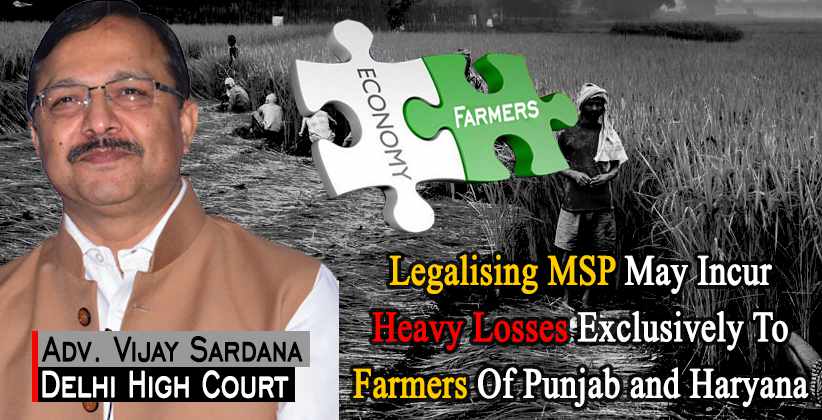The Swaminathan formula for MSP is based on an Outdated Cost Plus approach for India and will damage farmers' interest more, will also hurt the economy and encourage unsustainable agriculture practices more by supporting the inefficient and expensive agriculture production system and not including the vital factors of any economy factor like quality and productivity in MSP formula. Swaminathan Commission also not mentioned how to generate resources to support these recommendations and who should foot the bill?
The Concern with Swaminathan MSP Formula:
The Volume-5th of Swaminathan Report in section 2.3.5.6, page 57 says Expand the MSP system, based on the cost of production including a reasonable rate of return on investment and ensuring a prompt and open-ended purchase for all major crops''. Swaminathan commission failed to mention productivity criteria in the formula and also fails to mention the resources required to meet this recommendation and what will be the source of revenue to meet this obligation. Such recommendations will hurt farmers, natural resources and the economy of India. This is the reason that in the last 10 years productivity of paddy in Punjab has increased only by 2.7% whereas the MSP has gone up by 102%.
Changes in Wheat & Rice Yield and MSP in Punjab:
| Year | Change in Wheat Yield (Kg/ha.) | Change in Wheat MSP (Rs. / Qtl) | Change in Rice Yield (Kg/ha.) | Change in Rice MSP (Rs./ Qtl) |
| 2008-09 | 4462 | 1080 | 4022 | 900 |
| 2018-19 | 5183 | 1840 | 4132 | 1815 |
| Change | 16.16% | 70.37% | 2.73% | 101.67% |
On one hand, MSP is going up because of poor productivity, but the commission of the commission agents is also going up because it is linked to MSP in percentage terms. This clearly shows that there is no incentive to improve productivity and no interest in conserving water resources.
Damage to Natural Resources:
According to Punjab State government data, With 82% of the states land area witnessing a huge decline in underground water levels and 109 administrative blocks out of 138 placed in over-exploited category, a severe water crisis looms in the grain bowl of India. Experts from the Central Ground Water Board (CGWB) have pointed to the massive rate of fall in subsoil water by a whopping 51 cm per year.
With successive Punjab governments liberally subsidizing power up to the present about Rs 45,000 per tube well from a power subsidy budget of Rs 12,000 crore, groundwater extraction has gone unabated.
There are over 12.51 lakh agriculture power consumers, there are over 2 lakh enjoying up to two subsidised agriculture power connections and over 10,000 have four or more connections. This power is also misused for the non-agriculture purpose that is why the reforms in electricity supply are also opposed by farmer unions.
Data compiled by the CGWB between 2006 and 2017 point to groundwater decline up to two meters in 55% of wells, between two to four meters in 21% wells and above four meters in 7% wells in Amritsar, Tarn Taran, Kapurthala, Jalandhar, Ludhiana, Moga, Mansa, Sangrur, Barnala, Fatehgarh Sahib and Patiala districts.
FCI is paying MSP for wheat based on swaminathan formula which is unfit for human consumption
If MSP is higher than world market price and there is no mention of quality in MSP formula, there is a surplus in the country, who will buy the wheat crop from India. According to International trade standards as defined by Codex, FCI standard is not fit for human consumption for which FCI is paying MSP higher than the world market prices. Private tarde will buy from the world market as per their requirements, which will be not only cheaper but also of better quality and there is no scope for exports. Government will have to buy 100% wheat, it means government just for wheat has to allocate about Rs. 2 lakh crores plus cost escalation of at least 6% to meet inflation plus FCI over heads of 14% to buy wheat, plus 12% for disposal to states for PDS plus corruption, manipulation and pilferage extra. means additional Rs. Fifty thousand (50,000) crores extra with an increase of 6% every year. More importantly, farmers will sell all their crops at MSP and will prefer to buy wheat at Rs. 2 or 3 per kg from the PDS system. This subsidized wheat will come back to FCI at MSP. This circular economy will never end in this country and this will be an endless pit.
Let us assume the government decided to make MSP legally binding for the PDS system, then what will happen.
Implications of Legally Mandated MSP
Once MSP becomes a legal policy instrument, there cannot be preference for Punjab and Haryana or any other state. This will be gainst the natural justice and Right for Equality under the law as per constitution.
No law can create a preferential treatment of anyone state at the cost of other states as per the constitution in any public procurement. All decisions will come under the scrutiny of the Courts. Farmers of other states have all the reason to approach the Honble Supreme Court to seek justice and equal share in FCI procurement.
In order to avoid any litigation and to ensure transparency in the procurement system,the only option left with the FCI and government is to purchase the wheat for the central pool, from taxpayers money, as per the buffer norms on the pro-rata basis only. If that happens, let us calculate who will gain and who will lose in the new formula.
According to the available information from the Government websites, there are buffer norms for PDS systems. These buffer norms are important for budget allocation.
Table: Procurement of Wheat for the central pool as per the buffer norms:
| State | Production (in Mio Tons) | % of all India | FCI pro-rata basis purchase as per Buffer Norms | Statewise (2019-20) procurement by FCI (in Mio tons) | Who will gain/lose FCI procurement (in Mio tons) |
| UP | 32.75 | 32.04 | 8.84 | 3.7 | 5.14 |
| Punjab | 18.24 | 17.85 | 4.92 | 12.91 | (7.99) |
| MP | 15.47 | 15.14 | 4.17 | 6.725 | (2.56) |
| Haryana | 12.57 | 12.3 | 3.39 | 9.32 | (5.93) |
| Rajasthan | 10.49 | 10.27 | 2.83 | 1.411 | 1.42 |
| Bihar | 6.15 | 6.02 | 1.66 | 0.003 | 1.66 |
| Gujarat | 2.4 | 2.35 | 0.65 | 0.005 | 0.65 |
| Maharashtra | 0.95 | 0.93 | 0.256 | 0 | 0.26 |
| Uttrakhand | 0.94 | 0.92 | 0.25 | 0.042 | 0.21 |
| HP | 0.57 | 0.55 | 0.15 | 0.001 | 0.15 |
| Others | 1.66 | 1.62 | 0.45 | 0 | 0.45 |
| All India | 102.19 | 100% | 27.58 | 34.132 | (6.55) |
Conclusion: The biggest loser will be Punjab, followed by Haryana and MP.The government cannot buy 100% wheat produced in India. The private sector will also buy limited quantities, provided it is cheaper than imports. Currently, there is surplus production of wheat in India, therefore no one will stock in bulk. The annual increase in MSP will make exports difficult and imports attractive. The situation will become more complex in the coming years.Mandatory MSP based procurement will create more problems for wheat farmers in Punjab and Haryana. A similar case is for paddy.The problem of mandatory MSP is clearly visible in the sugar sector. Farmers must understand how the economy works and how the country has to plan for all stakeholders within its limited resources.
My Recommendation to Government of India:
Review Outdated Swaminathan Formula and make it relevant to promote productivity, sustainability and quality in Indian agriculture system.
MSP is only useful in a shortage economy, not in a surplus economy. India needs a better & logical approach to help farmers in place of outdated current Swaminathan MSP formula. According to the Swaminathan formula, higher the cost of production, higher should be the MSP and higher will be the commission for the commission agents because all calculations are based on the percentage of the cost of production. This is an illogical formula and will make Indian agriculture system's most resource inefficient and environmentally unsustainable. Organic farmers and Zero budget farmers will get less MSP because their cost of production is less than farmers using expensive inputs and fuel. Is this logical?
The Swaminathan formula for MSP is an outdated approach for India and will damage farmers' interest more and will also hurt the economy more by supporting the inefficient and expensive agriculture production system and not ignoring the vital factors of any economy factor like quality and productivity. This may be the reason why Prime Minister Dr Manmohan Singh never implemented the Swaminathan Formula for MSP.
(Vijay Sardana is an Advocate practicing at the Delhi High Court. Views expressed above are personal to the Author.)








